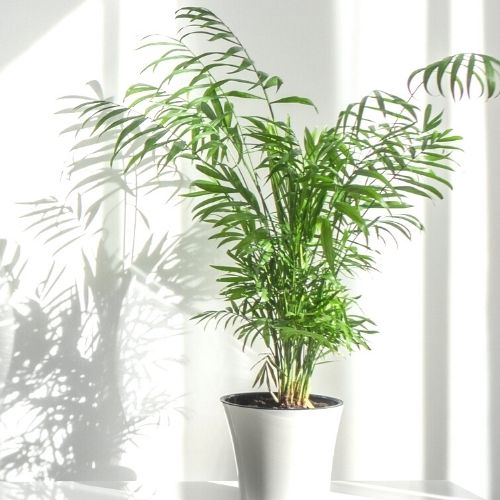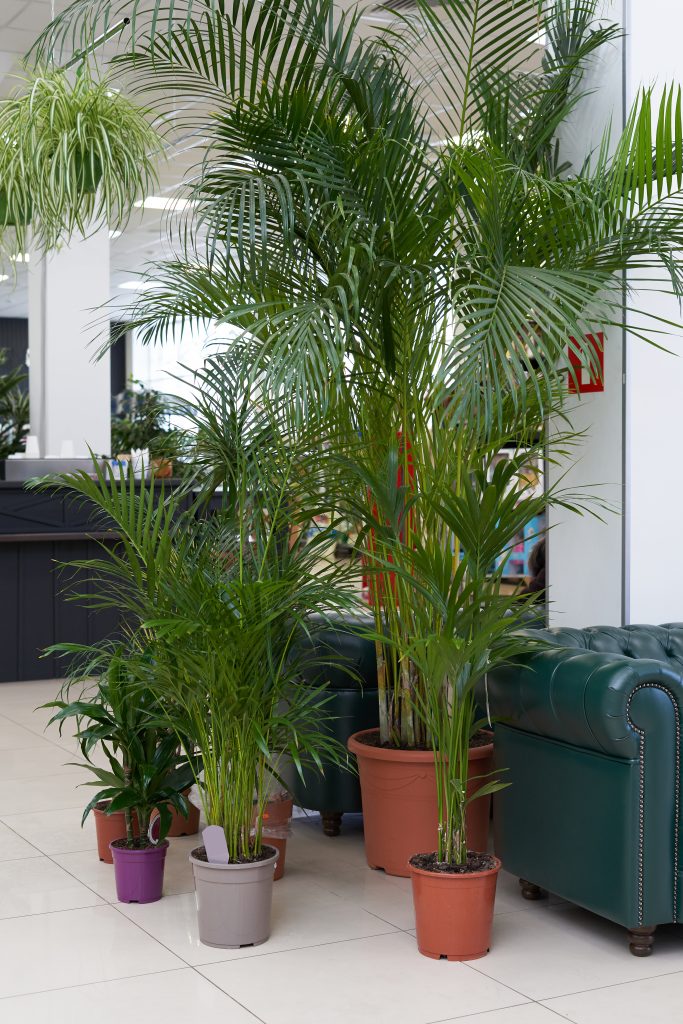
This post contains affiliate links. I will earn a small commission, at no extra cost to you, if you make a purchase through these links.
Parlor palms (also known as Chamaedorea elegans or Neanthe bella palm) are the very common indoor palms you find sitting in the corners of people’s living rooms all around the world.
While they might seem a bit common at first glance, this majestic, low-light palm shouldn’t be brushed off! In this post, I’ll explain how easy parlor palm care is and review how to propagate parlor palms, too.
Where can I buy a parlor palm?
You can easily find parlor palms for sale on Etsy. Check out this beautiful parlor palm from one of my favorite Etsy shops!
Parlor Palm Care
Here is a quick breakdown of how to care for the parlor palm, but read on for all the important care and propagation tips for success!
- Prefers medium light levels but also grows well in low light
- Water thoroughly when dry
- Use a well-draining potting mix
- Provide with humidity
How much sun does a parlor palm need?
I said in my introduction that parlor palms are low-light plants. They do well in low light, but their ideal lighting is moderate light. Make sure you don’t put your palm in direct sunlight, or else it will burn the leaves.
For help determining the light levels in your home and where your parlor palm will be happy, check out my easy guide to natural light for indoor plants.
Alternatively, you can use grow lights like the ones below which are my two current favorite grow lights!
(And, if you can’t see the images, click here to get my fave clip-on goose-neck grow lights and here for my fave stick-on grow light strips!)
My guide to grow lights for indoor plants has more helpful info for grow lights.
Watering
Water your parlor palm thoroughly when the potting mix is dry. Keep in mind, it will take much longer to dry out in low light than in bright light, so how often you water your plant largely depends on the light levels that you have it sitting in.
Be sure to stick your finger down into the potting mix to check for moisture before watering. This is extremely important to avoid overwatering and root rot.

Why are my parlor palm leaves turning brown?
There are a few things that can cause this, but the most common causes for brown leaves on parlor palms are overwatering or underwatering, and too much light or too little light.
Figuring out the cause is, luckily, pretty easy!
Always use your finger to feel for soil moisture BEFORE watering. If it’s still wet, let it dry out first before watering again.
If you notice your palm is always wet when you check it before watering, then you might be too aggressive with watering it, and vice versa if it’s always bone dry!
If you suspect it’s a light issue rather than watering, either raise or lower the light levels your plant receives for a few days and observe how it reacts.
Too little humidity can also sometimes be a problem. We’ll cover that next.
Should I mist my parlor palm?
Parlor palms are native to parts of Mexico and Central America (tropical areas!) and therefore thrive with extra humidity. You can mist your palm a few times a week to help provide extra humidity.
Some other methods of creating humidity include pebble trays, humidifiers, and more. My post on creating humidity for your houseplants explains more methods, step by step.
Potting Mix
A mix of one-part indoor plant potting mix, one-part peat moss, and one-part perlite or coarse sand works well for the parlor palm. The most important part is that it’s a well-draining mix.
Fertilizing
Parlor palms do not require a lot of fertilizer, so don’t go crazy with this! You can use a water-soluble indoor plant fertilizer once a month during the growing season (spring and summer).
Repotting
Parlor palms are slow growers, have weak root systems, and like to be on the rootbound side. Because of all that, you won’t need to repot this plant every year.
In general, repot this plant every two to three years, but if it’s still thriving as it is then don’t worry about repotting it. If you see roots coming out of the drainage holes then it’s definitely time to pot.
Be gentle while repotting because of their weak root systems, and use a pot that has good drainage and is the next size up from its current pot.
It’s always best to repot in the spring or summer, if possible.

Pruning
You shouldn’t prune your parlor palm because these plants grow from a terminal bud on the main stem, and cutting off that bud will cause your plant to completely stop growing.
Some houseplants can be pruned back to encourage new growth—this is not one of them!
What you can do is simply remove any dead, dried-up foliage by plucking it off or snipping it away from your plant, but don’t cut the actual stem of the plant.
Common Pests
Spider mites are common pests for parlor palms, but not to worry, there are some things you can do to get rid of them:
- First, quarantine the plant from other plants if you can move it. If you can’t move it, try to move other surrounding plants away from it
- If you can move it, bring it to the shower and spray down the entire plant. This will wash away the bugs
- Spider mites like dry air and dust, so misting the leaves with water (which can also be a part of your humidity process!) will help with treating and preventing spider mites
- Next, thoroughly wipe down the fronts and backs of the leaves to remove any webs or remaining mites
- Then, use an insecticidal soap to spray the entire plant, getting under the leaves and into any nooks and crannies. You may have to reapply every day until the problem is gone, but be sure to follow the instructions on the label. (Note that if you haven’t used the soap on your plant before, test it on a small patch first, just to be safe.)

How do you propagate a parlor palm?
Let’s address the elephant in the room: Parlor palms are not the easiest to propagate. Parlor palm propagation is typically done by growing new palms through seed.
Experienced growers or plant vendors will likely propagate their palms through seed, but for most of us, it’s not feasible and has a low success rate.
If you’re very determined to propagate your parlor palm, they can be divided, but the mother and the newly separated plant will both experience a period of shock that will cause some of the foliage to die back.
Therefore, you should only attempt this if you have a mature, healthy plant that has several stems.
- To divide your parlor palm, identify a stem that has its own separate root system. You’ll probably need to remove the entire plant from its pot and get your hands dirty to do this.
- As carefully as you can, separate that section from the rest of the mother plant, untangling any roots with your hands. If you cannot separate some of the tangled roots, use a clean, sharp knife to cut them away from each other, but keep as many roots intact as possible.
- Plant the section you’ve separated into an appropriately sized pot that has good drainage, and give it a good watering. Keep in mind, you might have to provide the newly planted stem with some support while it adjusts if it won’t stay upright.
Additional Information
Are parlor palms toxic to pets?
Parlor palms are non-toxic to cats and dogs, however, it’s best practice to keep all plants out of your furry friends’ reach regardless.
How big do parlor palms get?
Parlor palms as indoor plants typically grow anywhere from three to five feet tall.
They are slow growers, so if you really want that tall, palm-tree look, I would consider spending a little more money on a larger plant. Otherwise, you’ll be waiting for years for your palm to fill in that living room corner!


Sharon Brown says
My parlor palm has a very thin stem at the very bottom and gets larger as it goes up so I’m afraid it may get to heavy and break. How can I fix it or make it stable.
Anna says
I left my Palm outside one night by accident and since then(it’s been about a month now) the leafs have been different shades of brown and yellow. I tried repotting it, didn’t help. I gave it fertilizer as well but not much. I did get a few new sprouts but the majority are still brown/yellow/white.